
警告:多图杀猫!
每当提到机器学习,大家总是被其中的各种各样的算法和方法搞晕,觉得无从下手。确实,机器学习的各种套路确实不少,但是如果掌握了正确的路径和方法,其实还是有迹可循的,这里我推荐SAS的Li Hui的这篇博客,讲述了如何选择机器学习的各种方法。
SQLFlow is a bridge that connects a SQL engine, e.g. MySQL, Hive or MaxCompute, with TensorFlow, XGBoost and other machine learning toolkits. SQLFlow extends the SQL syntax to enable model training, prediction and model explanation.
PaddlePaddle 提供了丰富的计算单元,使得用户可以采用模块化的方法解决各种学习问题。在此Repo中,我们展示了如何用 PaddlePaddle来解决常见的机器学习任务,提供若干种不同的易学易用的神经网络模型。PaddlePaddle用户可领取免费Tesla V100在线算力资源,高效训练模型,每日登陆即送12小时,连续五天运行再加送48小时,前往使用免费算力。
笔者最近看了一些图与图卷积神经网络的论文,深感其强大,但一些Survey或教程默认了读者对图神经网络背景知识的了解,对未学过信号处理的读者不太友好。同时,很多教程只讲是什么,不讲为什么,也没有梳理清楚不同网络结构的区别与设计初衷(Motivation)。
因此,本文试图沿着图神经网络的历史脉络,从最早基于不动点理论的图神经网络(Graph Neural Network, GNN)一步步讲到当前用得最火的图卷积神经网络(Graph Convolutional Neural Network, GCN), 期望通过本文带给读者一些灵感与启示。
This is the repository for the backend of TabNine, the all-language autocompleter.
There are no source files here because the backend is closed source.
You can make feature requests by filing an issue. You are also welcome to make pull requests for changes to the configuration files.
languages.yml determines which file extensions are considered part of the same language. (For example, identifiers from .c files will be suggested in .h files.)
language_tokenization.json determines how languages are tokenized. For example, identifiers can contain dashes in Lisp, but not in Java.
If your feature request is specific to a particular editor’s TabNine client, please file an issue in one of these repositories:
You may be interested in these TabNine clients written by third parties:
If new features don’t work for you, check that you have the most recent version by typing TabNine::version into your text editor. If you don’t have the most recent version, try restarting your editor.
TabNine::config.d extension are now recognized as D source files (closes #56).- in identifiers when parsing Racket code.\d.*[a-zA-Z].*\d.*[a-zA-Z] from the project index. This is supposed to prevent long keys or base64 literals from occurring in autocompletion suggestions. The tokens are not filtered from the directory index or the file index..tsx files as TypeScript rather than .xml (closes #21).foo( it will additionally insert ) to the right of the cursor once the suggestion is accepted). The editor clients do not support this yet as it requires an upgrade to the communication protocol with TabNine; this is coming soon. Closes #11 as this is no longer an issue with the TabNine backend..git. This permits nested Git repositories (closes #5)..git (closes #8)..tabnineignore files (closes #15).TabNine::disable_auto_update into your text editor (closes #14).TabNine::config_dir to see where config files are being stored.其实用一下图片能更好的理解LR模型和决策树模型算法的根本区别,我们可以思考一下一个决策问题:是否去相亲,一个女孩的母亲要给这个女海介绍对象。

大家都看得很明白了吧!LR模型是一股脑儿的把所有特征塞入学习,而决策树更像是编程语言中的if-else一样,去做条件判断,这就是根本性的区别。
决策树基于“树”结构进行决策的,这时我们就要面临两个问题 :
弄懂了这两个问题,那么这个模型就已经建立起来了,决策树的总体流程是“分而治之”的思想,一是自根至叶的递归过程,一是在每个中间节点寻找一个“划分”属性,相当于就是一个特征属性了。接下来我们来逐个解决以上两个问题。
在生活当中,我们都会碰到很多需要做出决策的地方,例如:吃饭地点、数码产品购买、旅游地区等,你会发现在这些选择当中都是依赖于大部分人做出的选择,也就是跟随大众的选择。其实在决策树当中也是一样的,当大部分的样本都是同一类的时候,那么就已经做出了决策。
我们可以把大众的选择抽象化,这就引入了一个概念就是纯度,想想也是如此,大众选择就意味着纯度越高。好,在深入一点,就涉及到一句话:信息熵越低,纯度越高。我相信大家或多或少都听说过“熵”这个概念,信息熵通俗来说就是用来度量包含的“信息量”,如果样本的属性都是一样的,就会让人觉得这包含的信息很单一,没有差异化,相反样本的属性都不一样,那么包含的信息量就很多了。
一到这里就头疼了,因为马上要引入信息熵的公式,其实也很简单:
Pk表示的是:当前样本集合D中第k类样本所占的比例为Pk。
信息增益
废话不多说直接上公式:

看不懂的先不管,简单一句话就是:划分前的信息熵–划分后的信息熵。表示的是向纯度方向迈出的“步长”。
好了,有了前面的知识,我们就可以开始“树”的生长了。
解释:在根节点处计算信息熵,然后根据属性依次划分并计算其节点的信息熵,用根节点信息熵–属性节点的信息熵=信息增益,根据信息增益进行降序排列,排在前面的就是第一个划分属性,其后依次类推,这就得到了决策树的形状,也就是怎么“长”了。
如果不理解的,可以查看我分享的图片示例,结合我说的,包你看懂:
不过,信息增益有一个问题:对可取值数目较多的属性有所偏好,例如:考虑将“编号”作为一个属性。为了解决这个问题,引出了另一个 算法C4.5。
为了解决信息增益的问题,引入一个信息增益率:
其中:
属性a的可能取值数目越多(即V越大),则IV(a)的值通常就越大。信息增益比本质: 是在信息增益的基础之上乘上一个惩罚参数。特征个数较多时,惩罚参数较小;特征个数较少时,惩罚参数较大。不过有一个缺点:
使用信息增益率:基于以上缺点,并不是直接选择信息增益率最大的特征,而是现在候选特征中找出信息增益高于平均水平的特征,然后在这些特征中再选择信息增益率最高的特征。
数学家真实聪明,想到了另外一个表示纯度的方法,叫做基尼指数(讨厌的公式):

表示在样本集合中一个随机选中的样本被分错的概率。举例来说,现在一个袋子里有3种颜色的球若干个,伸手进去掏出2个球,颜色不一样的概率,这下明白了吧。Gini(D)越小,数据集D的纯度越高。
假设现在有特征 “学历”,此特征有三个特征取值: “本科”,“硕士”, “博士”,
当使用“学历”这个特征对样本集合D进行划分时,划分值分别有三个,因而有三种划分的可能集合,划分后的子集如下:
1.划分点: “本科”,划分后的子集合 : {本科},{硕士,博士}
2.划分点: “硕士”,划分后的子集合 : {硕士},{本科,博士}
3.划分点: “硕士”,划分后的子集合 : {博士},{本科,硕士}}
对于上述的每一种划分,都可以计算出基于 划分特征= 某个特征值 将样本集合D划分为两个子集的纯度:
因而对于一个具有多个取值(超过2个)的特征,需要计算以每一个取值作为划分点,对样本D划分之后子集的纯度Gini(D,Ai),(其中Ai 表示特征A的可能取值)
然后从所有的可能划分的Gini(D,Ai)中找出Gini指数最小的划分,这个划分的划分点,便是使用特征A对样本集合D进行划分的最佳划分点。到此就可以长成一棵“大树”了。
ID3:取值多的属性,更容易使数据更纯,其信息增益更大。
训练得到的是一棵庞大且深度浅的树:不合理。
C4.5:采用信息增益率替代信息增益。
CART:以基尼系数替代熵,最小化不纯度,而不是最大化信息增益。
因为数值缩放不影响分裂点位置,对树模型的结构不造成影响。
按照特征值进行排序的,排序的顺序不变,那么所属的分支以及分裂点就不会有不同。而且,树模型是不能进行梯度下降的,因为构建树模型(回归树)寻找最优点时是通过寻找最优分裂点完成的,因此树模型是阶跃的,阶跃点是不可导的,并且求导没意义,也就不需要归一化。
既然树形结构(如决策树、RF)不需要归一化,那为何非树形结构比如Adaboost、SVM、LR、Knn、KMeans之类则需要归一化。
对于线性模型,特征值差别很大时,运用梯度下降的时候,损失等高线是椭圆形,需要进行多次迭代才能到达最优点。
但是如果进行了归一化,那么等高线就是圆形的,促使SGD往原点迭代,从而导致需要的迭代次数较少。
Classification And Regression Tree(CART)是决策树的一种,CART算法既可以用于创建分类树(Classification Tree),也可以用于创建回归树(Regression Tree),两者在建树的过程稍有差异。
回归树:
CART回归树是假设树为二叉树,通过不断将特征进行分裂。比如当前树结点是基于第j个特征值进行分裂的,设该特征值小于s的样本划分为左子树,大于s的样本划分为右子树。

而CART回归树实质上就是在该特征维度对样本空间进行划分,而这种空间划分的优化是一种NP难问题,因此,在决策树模型中是使用启发式方法解决。典型CART回归树产生的目标函数为:

因此,当我们为了求解最优的切分特征j和最优的切分点s,就转化为求解这么一个目标函数:

所以我们只要遍历所有特征的的所有切分点,就能找到最优的切分特征和切分点。最终得到一棵回归树。
决策树的剪枝基本策略有 预剪枝 (Pre-Pruning) 和 后剪枝 (Post-Pruning)。
参考文章:决策树及决策树生成与剪枝
作者:@mantchs
过去一年中,我们比较了近22000个机器学习开源工程,并筛选了49个顶级项目(筛选率0.22%)。
其中包括以下6个分类
我们花了很大的精力筛选这个list,并小心的选择出2018年1月到12月间最好的工程。为了保证名单质量,Mybridge AI协同考虑了流行度、参与度、发布时间等多重因素。
计算机视觉
1、Detectron:facebook发布的目标检测工具【18913 star on Github】
项目地址:
https://github.com/facebookresearch/Detectron?utm_source=mybridge&utm_medium=blog&utm_campaign=read_more
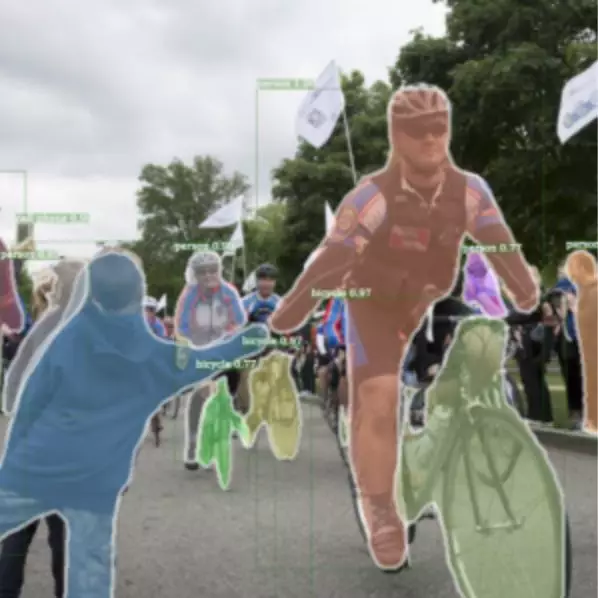
2、Openpost:多人实时特征点检测工具【11052 stars on GitHub】
项目地址:
https://github.com/CMU-Perceptual-Computing-Lab/openpose?utm_source=mybridge&utm_medium=blog&utm_campaign=read_more

3、DensePost:2维人体图片转3维的实时映射方法。【4165 stars on Github】
项目地址:
https://github.com/facebookresearch/Densepose?utm_source=mybridge&utm_medium=blog&utm_campaign=read_more
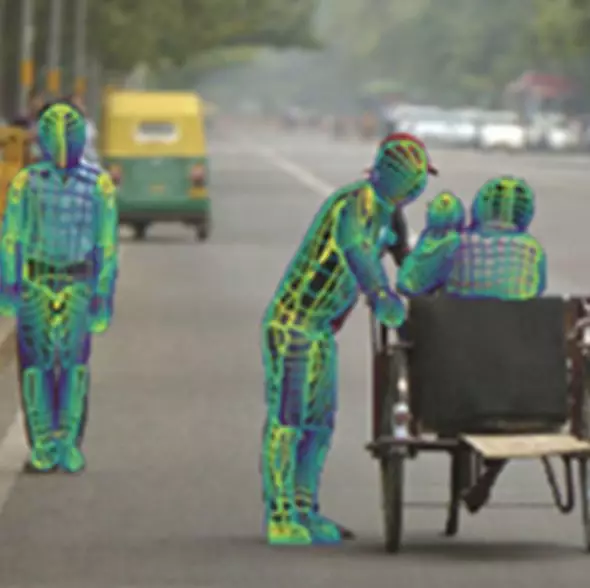
4、Maskrcnn-benchmark:(Pytorch)语义分割与目标检测工具包。【3888 stars on Github】
项目地址:
https://github.com/facebookresearch/maskrcnn-benchmark?utm_source=mybridge&utm_medium=blog&utm_campaign=read_more
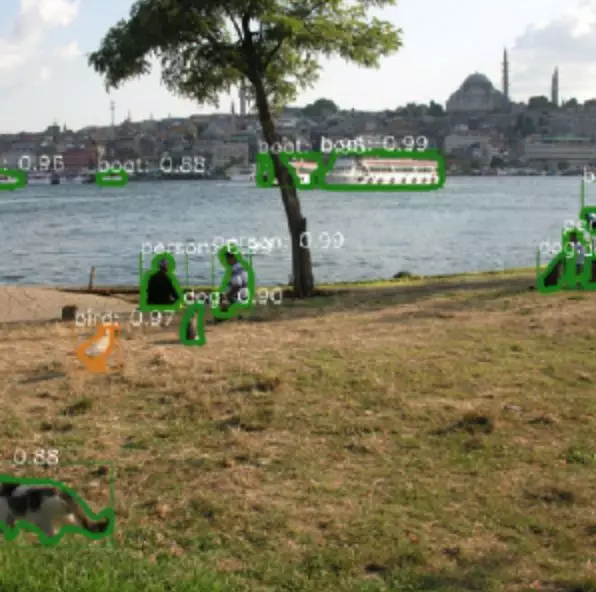
5、SNIPER:多尺度目标检测算法。【1963 stars on Github】
项目地址:
https://github.com/mahyarnajibi/SNIPER?utm_source=mybridge&utm_medium=blog&utm_campaign=read_more
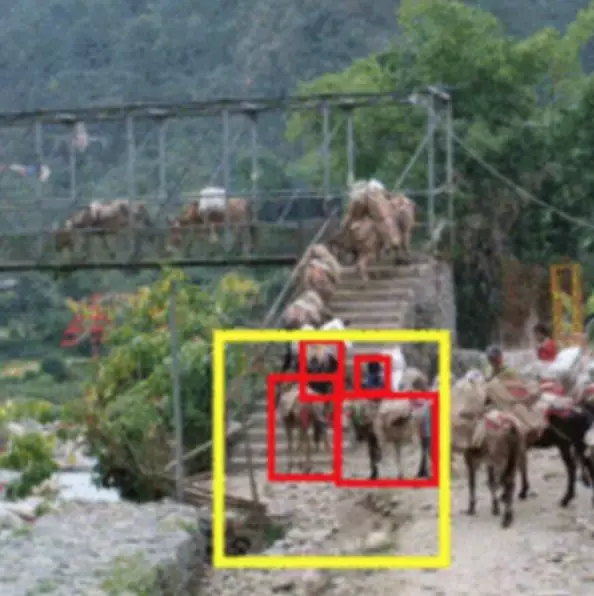
强化学习
6、Psychlab:Psychlab实验范例。【5595 stars on Github】
项目地址:
https://github.com/deepmind/lab/tree/master/game_scripts/levels/contributed/psychlab?utm_source=mybridge&utm_medium=blog&utm_campaign=read_more
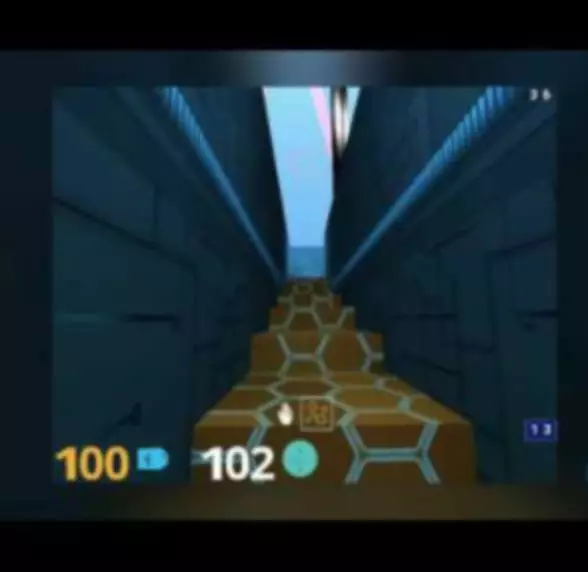
7、ELF:一个灵活、轻量、可扩展的游戏研究平台。【2406 stars on Github】
项目地址:
https://github.com/pytorch/elf?utm_source=mybridge&utm_medium=blog&utm_campaign=read_more
8、TRFL:(TensorFlow)强化学习agent工具包。【2312 stars on Github】
项目地址:
https://github.com/deepmind/trfl?utm_source=mybridge&utm_medium=blog&utm_campaign=read_more
9、Horizon:首个用于大规模需求的开源强化学习平台。【1703 stars on Github】
项目地址:
https://github.com/facebookresearch/Horizon?utm_source=mybridge&utm_medium=blog&utm_campaign=read_more
10、Chess-alpha-zero:国际象棋强化学习项目(基于AlphaGo Zero方法)。【1307 stars on Github】
项目地址:
https://github.com/Zeta36/chess-alpha-zero?utm_source=mybridge&utm_medium=blog&utm_campaign=read_more
11、Dm_control:DeepMind工具包。【1231 stars on Github】
项目地址:
https://github.com/deepmind/dm_control?utm_source=mybridge&utm_medium=blog&utm_campaign=read_more
12、MAMEToolkit:基于强化学习的电子游戏python库。【437 stars on Github】
项目地址:
https://github.com/M-J-Murray/MAMEToolkit?utm_source=mybridge&utm_medium=blog&utm_campaign=read_more
13、Reaver:模块化的深度强化学习框架(星际争霸2)。【355 stars on Github】
项目地址:
https://github.com/inoryy/reaver?utm_source=mybridge&utm_medium=blog&utm_campaign=read_more
NLP
14、Bert:BERT的TensorFlow代码,以及预训练模型。【11703 stars on Github】
项目地址:
https://github.com/google-research/bert?utm_source=mybridge&utm_medium=blog&utm_campaign=read_more
15、Pytext:基于Pytorch的神经语言模型框架。【4466 stars on Github】
项目地址:
https://github.com/facebookresearch/pytext?utm_source=mybridge&utm_medium=blog&utm_campaign=read_more
16、Bert-as-service:BERT模型的网络服务版本
项目地址:
https://github.com/hanxiao/bert-as-service?utm_source=mybridge&utm_medium=blog&utm_campaign=read_more
17、UnsupervisedMT:基于Phrase的无监督机器翻译方法。【1068 stars on Github】
项目地址:
https://github.com/facebookresearch/UnsupervisedMT?utm_source=mybridge&utm_medium=blog&utm_campaign=read_more
18、DecaNLP:NLP十项全能工具,多任务模型。【1648 stars on Github】
项目地址:
https://github.com/salesforce/decaNLP?utm_source=mybridge&utm_medium=blog&utm_campaign=read_more
19、NLP-architect:来自英特尔AI实验室的python工具包,包含了当前NLP领域的多种最佳模型。【1751 stars on Github】
项目地址:
https://github.com/NervanaSystems/nlp-architect?utm_source=mybridge&utm_medium=blog&utm_campaign=read_more
20、Gluon-nlp:NLP工具包。【1263 stars on Github】
项目地址:
https://github.com/dmlc/gluon-nlp?utm_source=mybridge&utm_medium=blog&utm_campaign=read_more
GAN
21、DeOldify:一个基于深度学习的图像补全工具包。【5060 stars on Github】
项目地址:
https://github.com/jantic/DeOldify?utm_source=mybridge&utm_medium=blog&utm_campaign=read_more
22、Progressive_growing_of_gans:GAN的变种实现,提高生产质量、稳定性以及多样性。
项目地址:
https://github.com/tkarras/progressive_growing_of_gans?utm_source=mybridge&utm_medium=blog&utm_campaign=read_more
23、MUNIT:多模态无监督图像翻译。【1339 stars on Github】
项目地址:
https://github.com/NVlabs/MUNIT?utm_source=mybridge&utm_medium=blog&utm_campaign=read_more
24、Transparent_latent_gan:使用监督学习来解释GAN的隐空间信息。【1337 stars on Github】
项目地址:
https://github.com/SummitKwan/transparent_latent_gan?utm_source=mybridge&utm_medium=blog&utm_campaign=read_more
25、Gandissect:基于Pytorch的可视化以及理解GAN的神经元信息。【1065 stars on Github】
项目地址:
https://github.com/CSAILVision/gandissect?utm_source=mybridge&utm_medium=blog&utm_campaign=read_more
26、GANimation:单张图片的表情变换。【869 stars on Github】
项目地址:
https://github.com/albertpumarola/GANimation?utm_source=mybridge&utm_medium=blog&utm_campaign=read_more
神经网络
27、Fastai:加速神经网络训练过程,并提高准确率。【11597 stars on Github】
项目地址:
https://github.com/fastai/fastai?utm_source=mybridge&utm_medium=blog&utm_campaign=read_more
28、DeepCreamPy:图像修复。【7046 stars on Github】
项目地址:
https://github.com/deeppomf/DeepCreamPy?utm_source=mybridge&utm_medium=blog&utm_campaign=read_more
29、Augmentor v0.2、图像增强工具包。【2805 stars on Github】
项目地址:
https://github.com/mdbloice/Augmentor?utm_source=mybridge&utm_medium=blog&utm_campaign=read_more
30、Graph_nets:Tensorflow的图网络构建工具。【2723 stars on Github】
项目地址:
https://github.com/deepmind/graph_nets?utm_source=mybridge&utm_medium=blog&utm_campaign=read_more
31、Textgenrnn:使用预训练字符级RNN生成文本。【1900 stars on Github】
项目地址:
https://github.com/minimaxir/textgenrnn?utm_source=mybridge&utm_medium=blog&utm_campaign=read_more
32、Person-blocker:图像中自动删除人像。【1806 stars on Github】
项目地址:
https://github.com/minimaxir/person-blocker?utm_source=mybridge&utm_medium=blog&utm_campaign=read_more
33、Deepvariant:DNA序列数据的分析工具
项目地址:
https://github.com/google/deepvariant?utm_source=mybridge&utm_medium=blog&utm_campaign=read_more
34、Video-nolocal-net:non-local神经网络的视频分类方法。【1049 stars on Github】
项目地址:
https://github.com/facebookresearch/video-nonlocal-net?utm_source=mybridge&utm_medium=blog&utm_campaign=read_more
35、Ann-visualizer:神经网络可视化工具。【922 stars on Github】
项目地址:
https://github.com/Prodicode/ann-visualizer?utm_source=mybridge&utm_medium=blog&utm_campaign=read_more
工具包
36、Tfjs:一个基于JS的ML模型训练部署工具包。【10268 stars on Github】
项目地址:
https://github.com/tensorflow/tfjs?utm_source=mybridge&utm_medium=blog&utm_campaign=read_more
37:Dopamine:快速的强化学习研究框架。【7142 stars on Github】
项目地址:
https://github.com/google/dopamine?utm_source=mybridge&utm_medium=blog&utm_campaign=read_more
38、Lime:分类器解释工具包。【5173 stars on Github】
项目地址:
https://github.com/marcotcr/lime?utm_source=mybridge&utm_medium=blog&utm_campaign=read_more
39、Autokeras:自动机器学习的开源软件库。【4520 stars on Github】
项目地址:
https://github.com/jhfjhfj1/autokeras?utm_source=mybridge&utm_medium=blog&utm_campaign=read_more
40、Shap:神经网络解释工具。【3496 stars on Github】
项目地址:
https://github.com/slundberg/shap?utm_source=mybridge&utm_medium=blog&utm_campaign=read_more
41、MMdnn:模型适配器。【3021 stars on Github】
项目地址:
https://github.com/Microsoft/MMdnn?utm_source=mybridge&utm_medium=blog&utm_campaign=read_more
42、Mlflow:机器学习生命周期管理。【3013 stars on Github】
项目地址:
https://github.com/mlflow/mlflow?utm_source=mybridge&utm_medium=blog&utm_campaign=read_more
43、Mace:面向移动计算平台的深度学习推断框架。【2979 stars on Github】
项目地址:
https://github.com/XiaoMi/mace?utm_source=mybridge&utm_medium=blog&utm_campaign=read_more
44、PySyft:关注安全性的深度学习库。【2595 stars on Github】
项目地址:
https://github.com/OpenMined/PySyft?utm_source=mybridge&utm_medium=blog&utm_campaign=read_more
45、Adanet:AutoML计算库。【2293 stars on Github】
项目地址:
https://github.com/tensorflow/adanet?utm_source=mybridge&utm_medium=blog&utm_campaign=read_more
46、Tencent-ml-images:最大的多标签图像数据库。【2094 stars on Github】
项目地址:
https://github.com/Tencent/tencent-ml-images?utm_source=mybridge&utm_medium=blog&utm_campaign=read_more
47、Donkeycar、开源的软硬件自动驾驶平台。【1207 stars on Github】
项目地址:
https://github.com/autorope/donkeycar?utm_source=mybridge&utm_medium=blog&utm_campaign=read_more
48、PocketFlow:自动模型压缩框架。【1677 stars on Github】
项目地址:
https://github.com/Tencent/PocketFlow?utm_source=mybridge&utm_medium=blog&utm_campaign=read_more
49、DALI:深度学习应用的优化工具包以及数据处理扩展引擎。【1013 stars on Github】
项目地址:
https://github.com/NVIDIA/dali?utm_source=mybridge&utm_medium=blog&utm_campaign=read_more
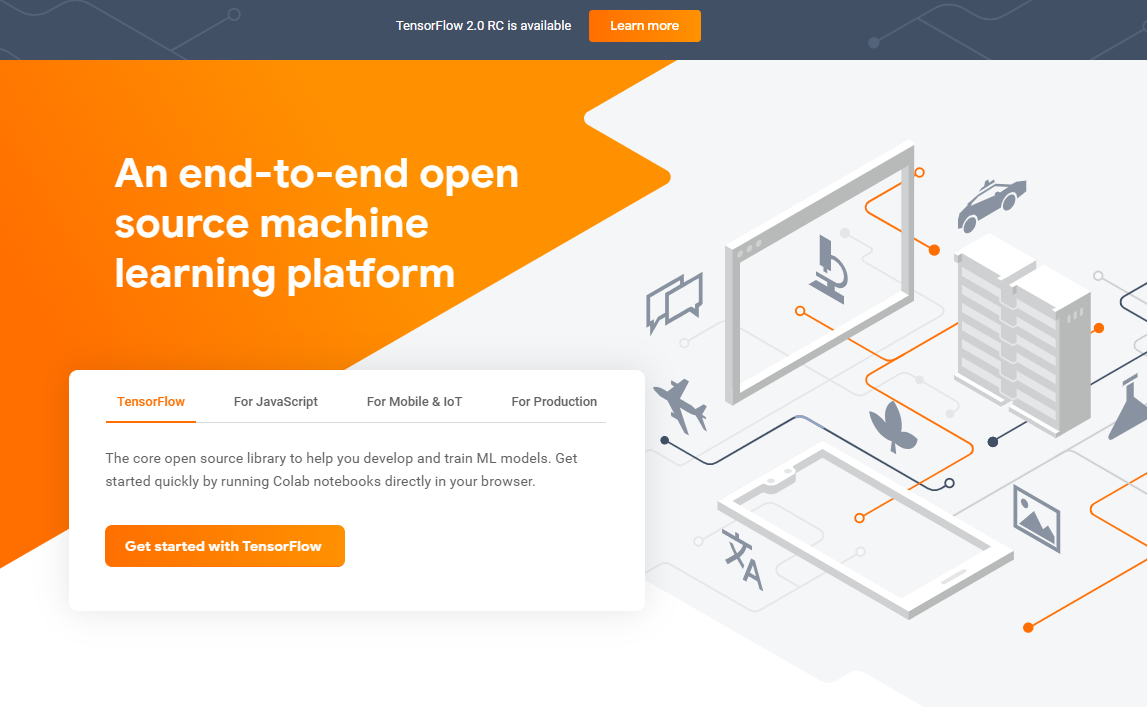
工具
探索可支持和加速 TensorFlow 工作流程的工具。
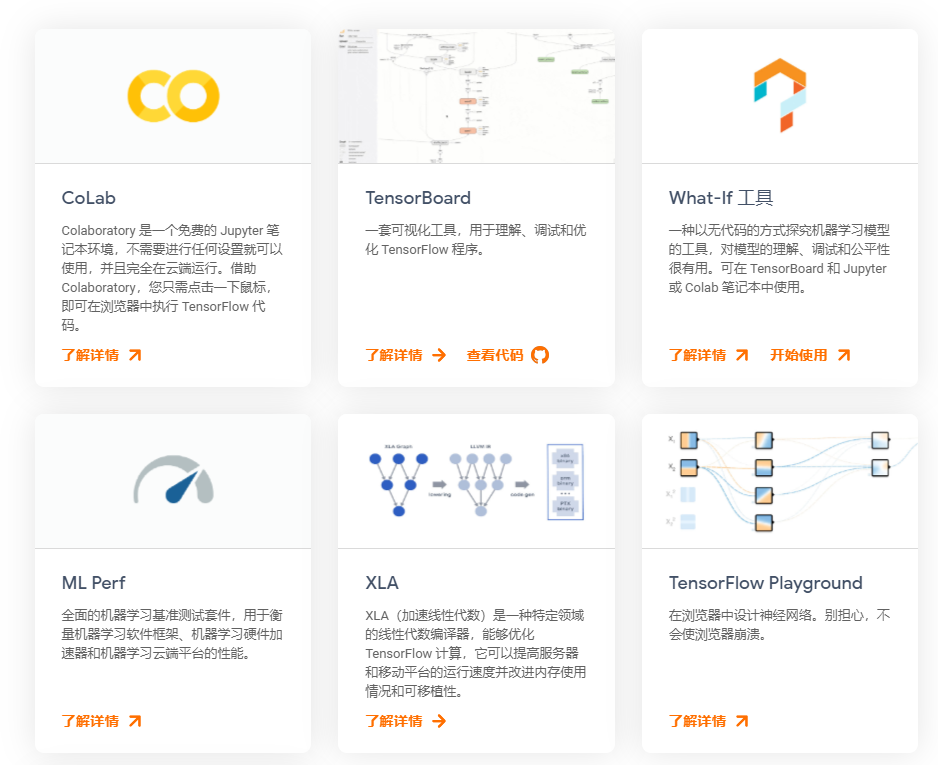
Colaboratory 是一个免费的 Jupyter 笔记本环境,不需要进行任何设置就可以使用,并且完全在云端运行。借助 Colaboratory,您只需点击一下鼠标,即可在浏览器中执行 TensorFlow 代码。
一套可视化工具,用于理解、调试和优化TensorFlow程序。
一种无代码的方式探究机器学习模型的工具,对模型的理解、调试和公平性很有用。可在TensorFlow和Jupyter或CoLab笔记本中使用。
全面的机器学习基准测试套件,用于衡量机器学习软件框架、机器学习硬件加速器和机器学习云端平台的性能。
XLA(加速线性代数)是一种特定领域的线性代数编译器,能够优化TensorFlow计算,它可以提高服务器和移动平台的运行速度改进内存使用情况和可移植性。
在浏览器中设计神经网络。别担心,不会使浏览器崩溃。
加入TensorFlow Research Cloud(TFRC)计划后,研究人员可于申请访问Cloud TPU来加快实现下一波研究突破;我们免费提供1000个Cloud TPU.
Update your browser to view this website correctly. Update my browser now